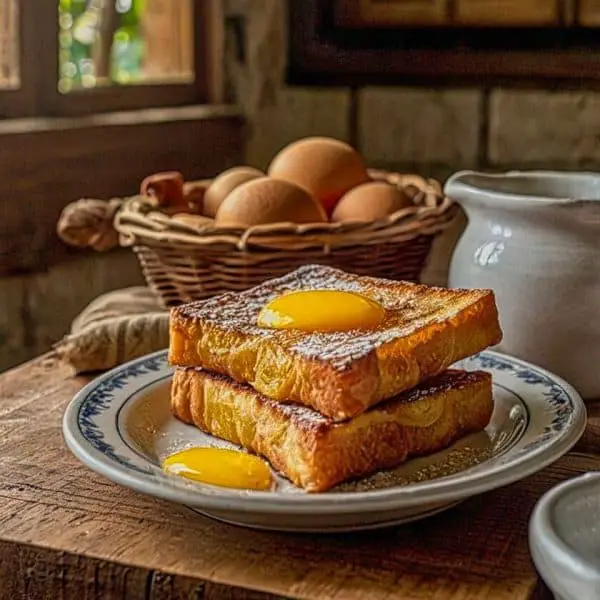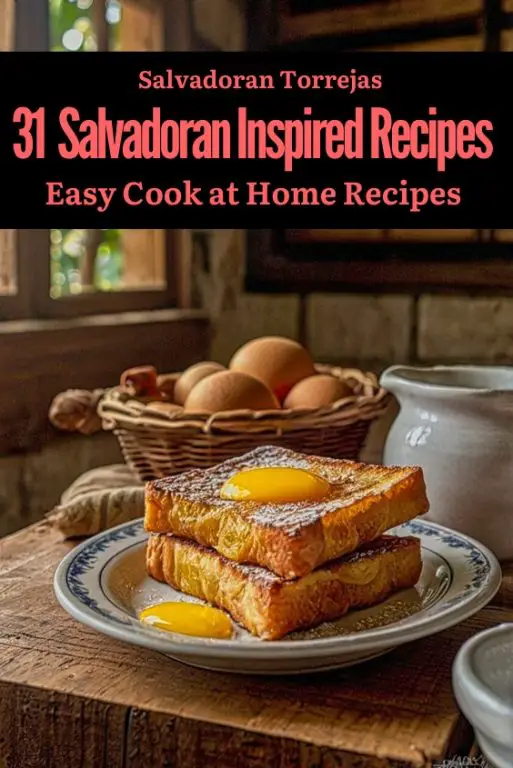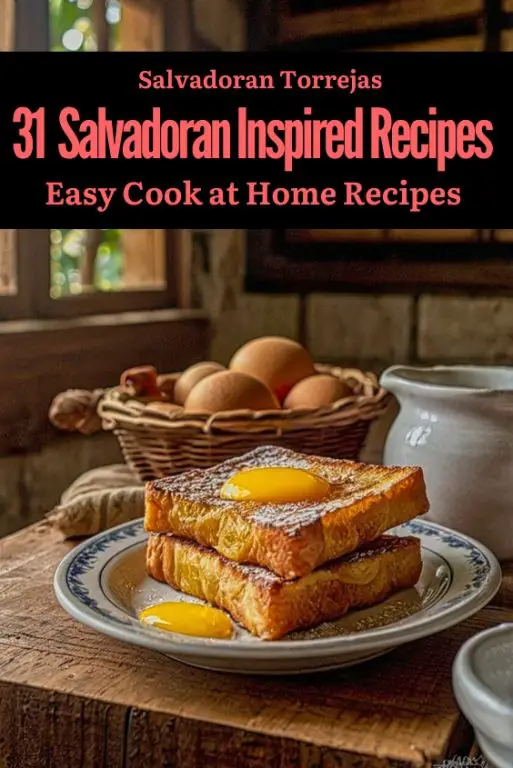The Salvadoran Torrejas recipe combines sweet flavors and cultural roots. Often compared to French toast, these golden-brown bread slices soaked in syrup are fried or baked. This dish demonstrates how to modify food without losing the flavor of an old favorite recipe.
Exploring the Salvadoran Torrejas recipe also highlights the cultural exchange through food. Use of ingredients like cinnamon and cloves reflect Central American cuisine. Cooks can make new versions of classic recipes like Torrejas by adding global flavors and techniques.
Cooking Torrejas in various styles such as fried in the traditional way or baked for a healthier option shows how versatile this dish can be. While frying gives Torrejas their crisp exterior, baking provides a softer texture with less oil and is an option for those looking for lighter foods. Either way, the basic Salvadoran Torrejas recipe is the same: traditional but open to innovation.
Ingredients For the Salvadoran Torrejas Recipe
Yucca
Grated Panela (brown sugar)
Water
Cinnamon Stick
Vegetable Oil
Eggs
Baking Powder
Salt
Ground Cinnamon
Cooking Instructions For the Salvadoran Torrejas Recipe
- Peel and grate the yucca into a large mixing bowl.
- In a saucepan, combine the grated panela, water, and cinnamon stick over medium heat. Stir occasionally until the panela has dissolved completely.
- Pour the panela mixture over the grated yucca and mix well.
- Heat the vegetable oil in a frying pan over medium-high heat.
- In a separate mixing bowl, beat the eggs until frothy.
- Add the baking powder, salt, and ground cinnamon to the eggs and mix well.
- Pour the egg mixture over the yucca mixture and stir until fully combined.
- Use a spoon to form the mixture into small round patties.
- Carefully place the patties in the hot oil and fry until golden brown on both sides.
- Use a slotted spoon to remove the torrejas from the oil and place them on a paper towel-lined plate to drain excess oil.
- Serve warm with a sprinkle of ground cinnamon on top.
10 Everyday Foods Eaten by Salvadoran Locals
Salvadoran cuisine is rich in flavour and tradition, with meals centred around simple, locally sourced ingredients. Many of the dishes Salvadoran locals eat daily are affordable, nutritious, and deeply tied to the country’s history. Here are ten everyday foods eaten by Salvadorans, giving you a glimpse into their culinary world.
1. Pupusas
Pupusas are perhaps the most iconic Salvadoran food. These thick, handmade corn tortillas are filled with ingredients like cheese, beans, or pork. They’re often served with a side of curtido, a fermented cabbage slaw, and tomato sauce. Pupusas are a staple meal and enjoyed by Salvadorans for breakfast, lunch, or dinner.
2. Casamiento
Casamiento is a traditional dish made of black beans and rice cooked together, often flavoured with onion and garlic. It’s a simple but hearty meal that pairs well with eggs, avocado, or tortillas. Locals eat casamiento throughout the day, especially as a filling side dish.
3. Yuca Frita
Yuca frita, or fried cassava, is another popular street food and side dish. The cassava is cut into thick slices and fried until crispy, then often served with curtido and chicharrón (fried pork). It’s a great snack that can be found in local markets and small food stalls.
4. Tamales
Salvadoran tamales are wrapped in banana leaves and filled with ingredients such as chicken, pork, or vegetables. The masa, or dough, is made from corn, giving it a slightly different texture compared to other Central American tamales. Tamales are commonly eaten on weekends or during special occasions but are also a beloved everyday meal.
5. Panes con Pollo
This Salvadoran sandwich features seasoned, shredded chicken in a fresh, crusty roll. It’s often dressed with a variety of vegetables, such as lettuce, tomatoes, cucumbers, and radishes, as well as a homemade tomato-based sauce. Panes con pollo is a popular meal for both lunch and dinner, offering a satisfying blend of flavours and textures.
6. Empanadas de Leche
Empanadas de leche are sweet, filled pastries made from mashed plantains and filled with a milk-based custard. Though they are a dessert, they are often eaten as a snack or even breakfast. These empanadas are a favourite among Salvadorans with a sweet tooth.
7. Atol de Elote
Atol de elote is a warm, comforting corn-based drink that’s often consumed as a snack or light meal. It’s made by blending fresh corn kernels with milk and sugar, then cooked until thickened. This mildly sweet beverage is enjoyed by locals for its nourishing qualities.
8. Sopa de Res
Sopa de res, or beef soup, is a common Salvadoran meal, especially on Sundays. The soup is hearty, made with beef, corn, carrots, potatoes, and other vegetables. It’s seasoned with herbs and served with a side of rice and tortillas. It’s both a comforting and nutritious option for lunch.
9. Torrejas
Torrejas are Salvadoran-style French toast. Bread slices are soaked in milk, sugar, and cinnamon, then fried until golden. These are typically served for breakfast or as a dessert, especially during festive times, but they’re also eaten casually at any time of day.
10. Plátanos Fritos
Fried plantains, or plátanos fritos, are a staple food across Latin America, and Salvadorans enjoy them as well. They can be served sweet with cream or cheese, or as a side dish to savoury meals like casamiento. Plantains are filling, affordable, and available year-round, making them an everyday favourite.
These ten everyday foods show how Salvadorans create simple yet delicious meals from locally sourced ingredients. Many of these dishes can be found in restaurants and street food stalls across El Salvador, offering visitors a true taste of the country’s culinary heritage.
FAQ For the Salvadoran Torrejas Recipe
Q: What is the history behind the Salvadoran Torrejas recipe?
A: The Salvadoran Torrejas recipe has deep historical roots, tracing back to Spanish colonial influences in Central America. Originally, torrejas were created as a way to use stale bread, turning it into a delicious dessert. This practice not only helped reduce food waste but also allowed families to create a sweet treat that could be enjoyed during special occasions or holidays. In Salvadoran culture, torrejas are often served during Lent and Holy Week, making them a traditional delicacy that has been passed down through generations. The recipe varies slightly from family to family, reflecting the unique flavors and preferences of each household.
Q: What ingredients do I need for the Salvadoran Torrejas recipe?
A: To prepare the Salvadoran Torrejas recipe, you will need a few essential ingredients. Stale bread, typically bolillo or other similar bread, is the primary component. Additionally, you’ll require eggs for coating the bread and milk to soak it, which adds richness to the dish. For sweetness, sugar and cinnamon are commonly used, while vanilla extract enhances the flavor profile. Finally, oil is necessary for frying the torrejas until they are golden and crispy. Some recipes might also include a drizzle of syrup or honey for serving, adding a delightful sweetness to the final dish.
Q: How do you make the Salvadoran Torrejas recipe from start to finish?
A: Making the Salvadoran Torrejas recipe involves several straightforward steps. First, slice the stale bread and soak it in a mixture of milk, sugar, and vanilla for about 10 minutes until it absorbs the liquid. Next, beat eggs in a separate bowl and dip the soaked bread slices into the eggs, ensuring they are well-coated. Heat oil in a pan over medium heat and fry the egg-coated bread slices until they are golden brown on both sides. Once cooked, remove them from the pan and drain on paper towels. Serve warm, optionally drizzled with syrup or honey for added sweetness.
Q: Can I modify the Salvadoran Torrejas recipe for dietary restrictions?
A: Yes, you can easily modify the Salvadoran Torrejas recipe to accommodate various dietary restrictions. For a gluten-free option, substitute regular bread with gluten-free bread, ensuring that all other ingredients are also gluten-free. If you’re looking to reduce sugar, consider using natural sweeteners such as agave syrup or honey in the soaking mixture and for drizzling. For a dairy-free version, almond milk or coconut milk can be used instead of regular milk, while flax eggs or chia seeds mixed with water can replace the eggs for a vegan option. These modifications allow you to enjoy torrejas while aligning with your dietary needs.
Q: What are some popular serving suggestions for the Salvadoran Torrejas recipe?
A: When serving the Salvadoran Torrejas recipe, there are various options to enhance the experience. A popular choice is to drizzle the torrejas with syrup or honey, providing a sweet contrast to the crispy exterior. You can also serve them with fresh fruit, such as sliced bananas or strawberries, which add freshness and a burst of flavor. Another option is to sprinkle powdered sugar or ground cinnamon on top for an appealing presentation. For a heartier meal, torrejas can be accompanied by a side of coffee or hot chocolate, making it a delightful breakfast or dessert option.

Salvadoran Torrejas
Equipment
- large mixing bowl
- Saucepan
- Frying pan
- Slotted Spoon
- Paper towel-lined plate
Ingredients
- 1 pound of yucca
- 1 cup of grated panela brown sugar
- 1 cup of water
- 1 cinnamon stick
- 4 cups of vegetable oil
- 4 eggs
- 1 teaspoon of baking powder
- 1 teaspoon of salt
- 1 teaspoon of ground cinnamon
Instructions
- Peel and grate the yucca into a large mixing bowl.
- In a saucepan, combine the grated panela, water, and cinnamon stick over medium heat. Stir occasionally until the panela has dissolved completely.
- Pour the panela mixture over the grated yucca and mix well.
- Heat the vegetable oil in a frying pan over medium-high heat.
- In a separate mixing bowl, beat the eggs until frothy.
- Add the baking powder, salt, and ground cinnamon to the eggs and mix well.
- Pour the egg mixture over the yucca mixture and stir until fully combined.
- Use a spoon to form the mixture into small round patties.
- Carefully place the patties in the hot oil and fry until golden brown on both sides.
- Use a slotted spoon to remove the torrejas from the oil and place them on a paper towel-lined plate to drain excess oil.
- Serve warm with a sprinkle of ground cinnamon on top.





1 comment
I made the Salvadoran Torrejas Recipe, and they turned out amazing. The bread was soaked in a sweet syrup and then fried to a golden brown.